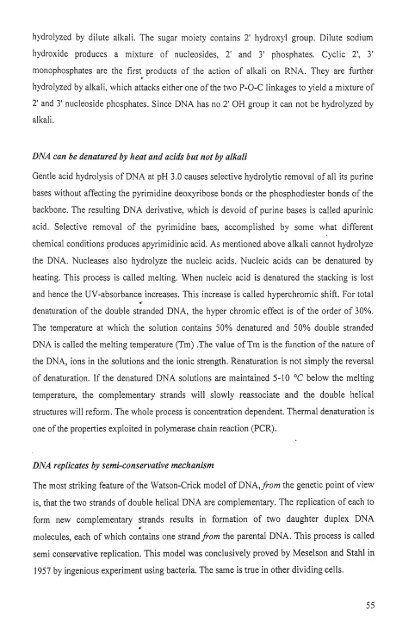, Diagnosis an-&& of Shrimp Diseases - Central Institute of ...
, Diagnosis an-&& of Shrimp Diseases - Central Institute of ...
, Diagnosis an-&& of Shrimp Diseases - Central Institute of ...
- No tags were found...
Create successful ePaper yourself
Turn your PDF publications into a flip-book with our unique Google optimized e-Paper software.
hydrolyzed by dilute alkali. The sugar moiety contains 2' hydraxj4 group. Dilute sodiumhydroxide produces a mixture <strong>of</strong> nucleosides, 2' <strong>an</strong>d 3"phsphates. Cyclic 2', 3'lnonophosphates are the first products <strong>of</strong> the action <strong>of</strong> alkali on RNA. They are furtherhydrolyzed by ailtali, which attacks either one <strong>of</strong> tile two P-0-C linkages to yield a mixture <strong>of</strong>2' <strong>an</strong>d 3' nucleoside phosphates. Since DXA has no 2' OH group it c<strong>an</strong> not be hydrolyzed byalkali.DNA c<strong>an</strong> be denatured by heat a~zd acids but not by alkaliGentle acid hydrolysis <strong>of</strong> DNA at pH 3.0 causes selective hydrolytic removal <strong>of</strong> all its purinebases without affecting the pyrimidine deoxyribose bonds or the phosphodiester bonds <strong>of</strong> thebackbone. The resulting DNA derivative, which is devoid <strong>of</strong> purine bases is called apurinicacid. Selective removal <strong>of</strong> the pyrimidine baes, accomplished by some what differentchemical conditions produces apyrimidinic acid. As mentioned above alkali c<strong>an</strong>not hydrolyzethe DNA. Nucleases also hydrolyze the nucleic acids. Nucleic acids c<strong>an</strong> be denatured byheating. This process is called melting. When nucleic acid is denatured the stacking is lost<strong>an</strong>d hence the UV-absorb<strong>an</strong>ce increases. This increase is called hyperchromic shift. For ,total6denaturation <strong>of</strong> the double str<strong>an</strong>ded DNA, the hyper chromic effect is <strong>of</strong> the order <strong>of</strong> 30%.The temperature at which the solution contains 50% denatured <strong>an</strong>d 50% double str<strong>an</strong>dedDNA is called the melting temperature (Tm) .The value <strong>of</strong> Tm is the function <strong>of</strong> the nature <strong>of</strong>the DNA, ions in the solutions <strong>an</strong>d the ionic strength. Renaturation is not simply the reversal<strong>of</strong> denaturation. If the denatured DNA solutions are maintained 5-10 "C below the meltingtemperature, the comple~nentary str<strong>an</strong>ds will slowIy reassociate <strong>an</strong>d the double helicalstructures will reform. The whole process is concentration dependent. Thermal denaturation isone <strong>of</strong> the properties exploited in polymerase chain reaction (PCR).DNA replicates by semi-conservative mech<strong>an</strong>isntThe most striking feature <strong>of</strong> the Watson-Crick model <strong>of</strong> DNA,from the genetic point <strong>of</strong> viewis, that the two str<strong>an</strong>ds <strong>of</strong> double helical DNA are complementary. The replication <strong>of</strong> each t<strong>of</strong>orm new complementary str<strong>an</strong>ds results in formation <strong>of</strong> two daughter duplex DNAZmolecules, each <strong>of</strong> which. contains one str<strong>an</strong>dfiom the parental DNA. This process is calledsemi conservative replication. This model was conclusively proved by Meselson <strong>an</strong>d Stahl in1957 by ingenious experiment using bacteria. The same is true in other dividing cells.
















